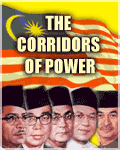Asabiyyah: a scourge according to PAS

The only way to end asabiyyah would be for, say, Indonesia to invade and conquer Malaysia, Brunei, Thailand, Philippines, Singapore, Myanmar, Cambodia, Vietnam, etc., and create a new Muslim empire a la the Ottoman Empire of more than 500 years ago where non-Muslims become second-class citizens and would be required to pay a special tax.
THE CORRIDORS OF POWER
Raja Petra Kamarudin

First see the video below regarding the statement by Mahfuz Omar, the PAS vice president and the head of PAS Kedah.
PAS has been very consistent in its stand regarding its opposition to asabiyyah since way back, as it is about its stand on the Islamic State. And this was one reason why those from the ‘Islamic wing’ of Umno broke away from the party in 1955, two years before Merdeka, to form the Pan-Malayan Islamic Party (then called PMIP and now known as PAS).
Asabiyyah comes from the word asabah, which means your relatives from your father’s side (abah means father). I suppose some would call this nepotism but asabiyyah in the context of politics more accurately refers to nationalism.
Tribalism, clanism, parochialism, racism, sectarianism, provincialism, regionalism, sectionalism, etc., can also tantamount to asabiyyah.
Anyway, you can read more on the subject below if you require a better understanding of the concept.
In arguing its case against asabiyyah, PAS always refers to Prophet Muhammad’s Final Sermon (a.k.a. ‘The Farewell Sermon’) delivered on 9th March 632 on Mount Arafat where the Prophet clearly stated that God is against racism. Hence asabiyyah, in the context of Islam, is viewed as racism (because the Prophet talked about the different ‘colours’ of humans that God created) — which means that racism is forbidden in Islam.
Now, Umno, MCA and MIC are race-based political parties. This would mean that these three parties violate Islamic tenets and hence would be considered haram in Islam. And that was why PAS said that Umno is a kafir (infidel) party since way back in the 1970s — because it is a racist party, which is forbidden in Islam.
In that sense, nationalism would also be considered asabiyyah, and therefore haram, mainly because it lumps Malaysians into a grouping. In Islam, you must fight for a Muslim ummah (community), not for nationalism, which divides Muslims into various countries.
In short, Malaysia must not exist. If it does it will be asabiyyah. What should exist instead is a community (meaning new country) of Muslims from Indonesia, Malaysia, Brunei, Thailand, Philippines, Singapore, Myanmar, Cambodia, Vietnam, and so on.
If Muslims are separated or divided into various countries such as Indonesia, Malaysia, Brunei, Thailand, Philippines, Singapore, Myanmar, Cambodia, Vietnam, etc., then we are practicing asabiyyah, which Islam (and PAS as well, I suppose) is against.
And to sing Negara Ku and salute the Malaysian flag would also be asabiyyah because it smacks of nationalism, and hence is haram.
The only way to end asabiyyah would be for, say, Indonesia to invade and conquer Malaysia, Brunei, Thailand, Philippines, Singapore, Myanmar, Cambodia, Vietnam, etc., and create a new Muslim empire a la the Ottoman Empire of more than 500 years ago where non-Muslims become second-class citizens and would be required to pay a special tax.
*******************************************
Asabiyya or asabiyyah (Arabic: عصبية, ʻaṣabīya) refers to social solidarity with an emphasis on unity, group consciousness and sense of shared purpose, and social cohesion, originally in a context of “tribalism” and “clanism”. It was a familiar term in the pre-Islamic era, but became popularized in Ibn Khaldun’s Muqaddimah where it is described as the fundamental bond of human society and the basic motive force of history. Asabiyya is neither necessarily nomadic nor based on blood relations; rather, it resembles philosophy of classical republicanism. In the modern period, the term is generally analogous to solidarity. However, the term is often negatively associated because it can sometimes suggest loyalty to one’s group regardless of circumstances, or partisanship.
Ibn Khaldun uses the term Asabiyyah to describe the bond of cohesion among humans in a group forming community. The bond, Asabiyyah, exists at any level of civilization, from nomadic society to states and empires. Asabiyyah is most strong in the nomadic phase, and decreases as civilization advances. As this Asabiyyah declines, another more compelling Asabiyyah may take its place; thus, civilizations rise and fall, and history describes these cycles of Asabiyyah as they play out.
Ibn Khaldun argues that each dynasty (or civilization) has within itself the seeds of its own downfall. He explains that ruling houses tend to emerge on the peripheries of great empires and use the much stronger asabiyya present in those areas to their advantage, in order to bring about a change in leadership. This implies that the new rulers are at first considered “barbarians” by comparison to the old ones. As they establish themselves at the center of their empire, they become increasingly lax, less coordinated, disciplined and watchful, and more concerned with maintaining their new power and lifestyle at the centre of the empire—i.e, their internal cohesion and ties to the original peripheral group, the asabiyya, dissolves into factionalism and individualism, diminishing their capacity as a political unit. Thus, conditions are created wherein a new dynasty can emerge at the periphery of their control, grow strong, and effect a change in leadership, beginning the cycle anew.
Khaldun’s central concept of asabiyyah, or “social cohesion”, seems to anticipate modern conceptions of social capital arising in social networks.
This cohesion arises spontaneously in tribes and other small kinship groups; and it can be intensified and enlarged by a religious ideology. Khaldun’s analysis looks at how this cohesion carries groups to power but contains within itself the seeds – psychological, sociological, economic, political – of the group’s downfall, to be replaced by a new group, dynasty or empire bound by a stronger (or at least younger and more vigorous) cohesion.
http://en.wikipedia.org/wiki/Asabiyyah
*******************************************
{youtube}f7qRaF970Zg{/youtube}
SEE VIDEO ON YOUTUBE HERE: http://www.youtube.com/watch?v=f7qRaF970Zg

